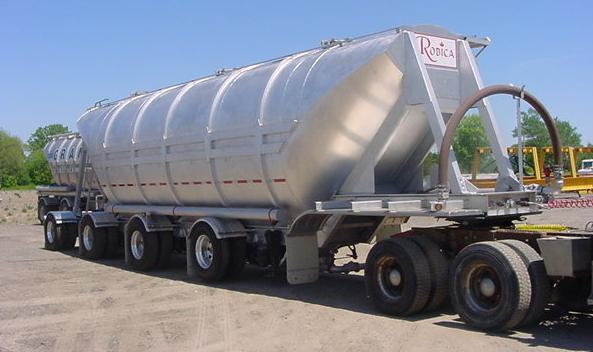Dry Bulk Tank Trailer Loading
Most if not all dry bulk tank trailers
take advantage of gravity to fill them
as it is simplest and least expensive way to
do it
Using a an air stream to blow said material into the
filling hatch or hatches is counterproductive as each
hatch is opened before loading to insure the loading
is distributed properly along the length of the trailer
to permit a legal load of 22 tons (US weight) here anyway.
The dust generated would be huge as the air volume and the
fugitive dust will seek its weakest point of exit being the tank hatch or hatches. ■
Re: Dry Bulk Tank Trailer Loading Procedure
Dear Mr. Andre Daunais
Filling a bulk truck pneumatically is not really a feasible method.
The problem is that the conveying air has to be vented from the bulk truck and de-dusted and the collected dust must be returned into the material stream or disposed off.
The proper way to load a bulk truck is by an overhead hopper with vent filter, which is filled pneumatically and a loading below underneath that hopper.
The loading bellow is lowered into a hatch opening of the bulk truck and the bulk truck is loaded by gravity.
Underneath the outlet of the loading bellow, a Rotary Paddle Level Switch is mounted for level detection as a safety.
Normally, the loading is stopped when the maximum road weight is reached.
That can be measured by loading the bulk truck on a weigh bridge.
Experienced drivers monitor the pressure in the pneumatic suspension system of the bulk truck axle.
They know by experience at which suspension pressure when the maximum load is reached.
Have a nice day ■
Teus
Consultant You Say?
Loading by pneumatics would be a bad joke and a qualified tanker driver such as myself would never entertain such a procedure,by law.
If there are multiple manhole covers, not hatches please, at least one has to be open for filling and this would exhaust dust at an unacceptable rate. After exhaustive filling, ho ho ho I don't know how I thought of that, you then expect the driver to close the hatch and open the next one while working in dangerously dusty conditions at a height of at least 4.2m where vision and breathing are seriously impaired by the said dust. It is illegal under ADR rules.
There is a collapsible handrailing interlocked with the parking brake, by law. To swing a spout and bellows between the manholes is precarious in good viewing conditions and if pneumatic filling was used it would be downright dangerous at best with a single handrail to protect the driver.
Tankers use an 80-20 rule for capacity. We never operate <20% or >80% because below these values the surge during braking is very tricky and above these values the variance in ullage can result in overpressure which in turn leads to potential injury when the manholes are opened.
There is no way that a driver can accurately monitor the pressure in the airbags to estimate the load. Any suspension worth its salt changes level in sympathy with the imposed load if the key is switched on one notch before starting. There is also a disable switch on the pendant behind the driving seat so that the air is locked in the system, or not, as the loading operation demands. I have driven Kenworth, Atkinson, Scania Vabis, Leyland, Volvo, Mercedes Benz, Manheim Augsberg Nurenberg (MAN), Foden and Iveco trucks and have never seen a pressure gauge which indicated anything other than the presence of some air in the system. We tried to get some sense out of a leveling valve in the early days, 1968, when air suspension was quite new and I was working as Experimental Engineer cum Test Driver at Atkinson. The real instrumental pressure gauges told us sod all and were thrown out in favour of just watching the roll on fast bends....those were the days.
Powders aerate under gravity filling which is why the tubs are so big compared to liquid tanks. It is a matter of familiarity when driving powders. If the journey is too smooth the powder will loose aeration and not unload as fast. If the roads are rough, very hard to judge with luxurious air-rides, there is a possibility the powder will vibration consolidate at lower strata which will slow the emptying process as well.
Professionals use gravity filling through a retractable spout and measure the contents with a DIPSTICK, an English term. ■
John Gateley johngateley@hotmail.com www.the-credible-bulk.com
Re: Dry Bulk Tank Trailer Loading Procedure
Dear Author,
for the answer it is important to konw if the truck can bring the silo to an upright Position or no.
Frank Pahl
Regards.
Photo added by Administrator as an example only:

■
Re: Dry Bulk Tank Trailer Loading Procedure
Pneumatic conveying is commonly used to load shipping trucks, but the conveying system is designed to gravity feed the material into the truck using a Receiving Hopper with a collapsible loading chute at its bottom. Conveying air is vented out of the Hopper to a dust collector mounted at grade. The loading chute has a hanging level switch that hangs inside the truck. This switch is activated when the level becomes high.
The conveying system stops automatically when the level in the truck becomes high.
These loading chutes are made by many vendors.
Regards,
Amrit Agarwal
Pneumatic Conveying Consulting
Email: polypcc@aol.com ■





Dry Bulk Tank Trailer Loading Procedure
How to detect a high level into a dry bulk tank trailer and to command automatically the stop of the pneumatic conveyor system without the truck driver during the filling operation. How is done the detection?
Regards.
Photo added by Administrator as an example only:
Dry Bulk Trailer ■